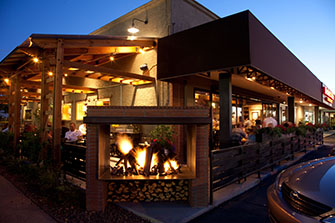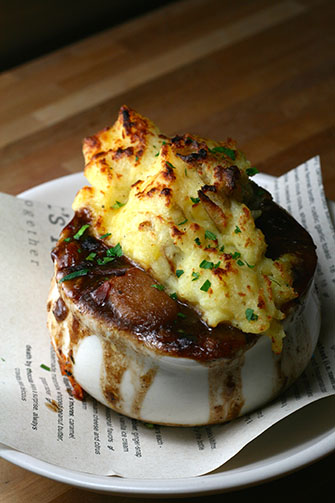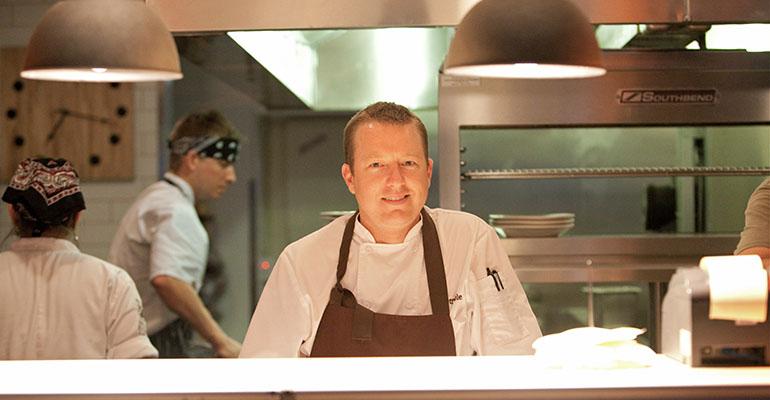Justin Beckett operates two popular restaurants in Phoenix, land of untold bland strip malls, lifestyle centers and middling chain eateries. Beckett, who arrived in the Valley of the Sun 19 years ago as a member of the Roy’s Restaurant team, has seen a lot of shifts in the city's dining culture in the last two decades as the metro population has swelled from 2.8 million to 4.5 million. He recently shared his experience opening two restaurants and his take on the local dining landscape.
Your first restaurant, Beckett’s Table, opened in 2010. How did that project come together?
In the mid-2000s, Fred and Jennifer Unger, who own some boutique hotels, were doing a project called SouthBridge, a collection of shops and restaurants. I opened four restaurants there, and as director of culinary I got immersed in numbers and operating with large teams, and that kind of stuff. Then the economy happened, and it all came to a screeching halt.
I’m sitting having a burger with friend and now business partner, Scott Stephens, and we’re talking: Should you? Should we? What do you think? He and his wife (Katie) and my wife (Michelle) and I sat down and drank a few too many bottles of wine and wrote down everything we thought a restaurant should be that didn’t exist at that moment in Arizona. Four or five pages later we decided this was a good background for a restaurant. Scott and I spent the next nine or ten months looking for locations. After all kinds of faux pas and mishaps, we landed the lease on this place.
We found some investors, and we did all the demolition ourselves. This had been a restaurant for 40 years and nobody had ever gutted it. So we took down four or five layers of drywall. All the bow truss ceilings were covered. We cut holes in the walls to let in some light and built a patio—a necessity in Arizona. We tried to use as much reclaimed stuff as we could—all of the wood slats in the wine room are palates from our deliveries, for instance. Simple things like that make a big difference.
Where did that imposing communal table come from?
Scott, Katie and Michelle were trying to convince me that my name should be on the restaurant, and I wasn’t sold on it. We knew we wanted a communal table and we heard about this guy in Portland, OR, who gets phone calls from the National Forest Service when trees are in danger of falling on something and he cuts them down, So we traveled there to take a look. He had huge slices of this black walnut tree. He lifted all these pieces up with a forklift and said, "Do you like this one? This one? This one?" We picked one, and someone said, “This is Beckett’s table,” and we had the name. He brought it down on a flatbed, and we went to see it next morning, and it was a canoe. We had to clamp it to get it flat again. It naturally wants to bow, so we have huge steel plates attached underneath to prevent that. It seats 18-20 people. During the summer we do a “grownups’ table,” our version of going to someone’s house and sitting at the grownups’ table. You get multiple courses paired with wine and a to-go bag with all the leftovers. On a busy night we make it available to walk-ins. Groups of four and two sit down when there are no available tables. It’s kind of turned into a hot commodity.
So the gamble paid off.
From day number four we have been busy. We also deserve it—we work really hard and treat our people well. We try to create a family atmosphere and really take pride in our guests being happy. We try to deliver a five-star experience that’s not snooty and we charge three-star prices. We have an outstanding wine list, and serve locally raised food with great care and creative energy put into it, and we try not to charge $100 a person. We try to make it so you can come in three or four times a month.

We also opened at a very fortunate time. The economy was very slow, and there was not a lot to write about on the culinary scene. But a lot of people like me from in the have really committed to leaving their bigger jobs and funding these smaller independent restaurants. I would say in the last five years the food scene has doubled in quantity and quality.
As casual as this place looks it seems surprising that you do dinner only.
We are also closed on Mondays. Some really great advice we got early on is: It’s the four of you running this restaurant. You’re going to need time to fix stuff and do projects, and you’re going to need down time. So we decided Monday would be a good time to do that. We’re also in the same parking lot as a sports bar, and that sports bar on Monday nights goes crazy. So parking is a big issue. The other reason is that this room doesn’t necessarily shine as much during the day. If we were to open for brunch or lunch we would probably commit to popping some skylights in the roof and bringing in a little more light.
Managing a second restaurant
How did your second restaurant come together?
A few years ago we got a phone call from a very respected restaurateur in town who said he knew some people working on a project and he wanted us to talk to them. This location for many years had been an iconic restaurant called The Beef Eaters. It was an 18,000 sq. ft. restaurant. We walked through it. They had to send cops through it first because it had been closed so long people were living there. We all saw the devastation and how ridiculously horrible and dilapidated the whole thing was, but when we all got in the car and left we all said, “We have to do this project to be part of Phoenix history.” Working with a partner who purchased the building we did a complete overhaul and literally took it apart with a fine tooth comb. Every time we took something apart we asked how can we use it, what can we do? So the sign is the old sign shape but with new words. We buried the old sign letters in the concrete so when you enter the property you walk over the old sign.
The restaurant is called Southern Rail, and we do American classics with a southern twist. Southern concepts are very hot right now and we wanted to share that with Phoenix. It’s about 250 seats, and we also run an event space that has about 250 seats. This is the 18th restaurant I’ve done and I’ve designed that same kitchen a number of times, and we really designed it with catering in mind. There’s more equipment and more line space so I can plate a 150-person party without disrupting the hot line.
Southern Rail is open seven days a week and we serve lunch, brunch and dinner. It’s more like a machine than Beckett’s Table.

I’m usually in both places every day—they are 12 minutes apart. And I live in between the two. So my car knows the triangle very well. I think it’s important for me to be present. Scott and Katie and Michelle and I have always been hands-on owners. I collect a salary because I fill a position. I am a chef in both restaurants. I never remember saying in culinary school, “I can’t wait to sit in an office and do paperwork.” No self-respecting chef ever thinks that’s why they got into the business.
What are some changes you've seen in the restaurant business here since you arrived?
In Hawaii you don’t cook fish all the way through. In 1997, when we opened Roy’s (a concept originated in Hawaii by chef Roy Yamaguchi), we tried to serve all our fish medium rare, and it was just a nightmare. Every single piece got sent back. So we went to this term “cooked through moist,” and we started cooking the fish longer, and no more send-backs. So it was a very different town. When I arrived there were four or five well-known chefs in town—the godfathers. Now there are lot of people like me: small, independent, local, interested in hiring a small group of culinary missionaries and making really great food that features Arizona products.
And Arizona wine, too, right? It’s not exactly a household name.
This is the same problem Arizona’s food scene faces. Because every time you see a nationally televised Suns game or Diamondbacks game, what do they show you? Cactus and tumbleweed, and a statue in Old Town Scottsdale of a cowboy. So there’s a perception that we live in this backwards desert. But our wine scene today is probably further along than the Oregon wine scene was 20 years before they popped on the scene. We have 85 or 90 wineries. We have great, great terroir. What could be worse than 120 degrees in the desert? But these vines love it. They love the clay, they love the earth, they love extreme temperatures. Arizona’s got 6 or 7 of the 7 or 8 climates in the world. The wine is ridiculously good.
At Southern Rail we have an all American wine list, and I would bet 70 percent of that is Arizona wine, and Wine Spectator gave us the nod, they said you guys are doing something innovative and cool, and we support it. At Beckett’s Table we have New World and Old World wines, and the majority of our New World selection is Arizona wine. On Sundays and Mondays we sell half-price Arizona bottles; that is our commitment to how important we think Arizona wine is.
Challenges to ownership
What are the biggest challenges to owning a restaurant here?
I think the area is growing so fast that we don’t have the staff to support growth. So we do a really good job of keeping our crew. Getting people out of culinary school and getting them trained in the way we think and do things is a challenge. I really stay out of politics. Do we raise our tax when they tell us to and pay tax when they tell us to? Of course. But our minimum wage and the cost of living are fairly low compared to the rest of the U.S. The local sheriff is making noise about illegals, but I think it’s going to balance out and we’re going to have to figure out a way to make it happen.
You’re known as a social media-savvy chef. What’s your preferred social media outlet?
People love looking at pictures of food, so Instagram has been really great.
We opened Beckett’s Table with more than 1,000 followers on Facebook. Then, that was a big deal; now it’s nothing. We started with Facebook and Twitter, and Foursquare came on strong, then Instagram. We would love to be very interactive and video friendly. These are just lofty goals. When I have a chance to wash my hands and get out of the kitchen, these are the things I want to focus on.
To have somebody who is social media-savvy, who understands numbers, who can cook, who can lead, who can guide and is also a face for the public…we don’t take that for granted. We’re fortunate to have those kinds of people in our company.
Do you see yourself opening more restaurants down the road?
I think both of these concepts have the legs to have second locations. I could see these in new locations in the Phoenix area and in another part of the world. We would not want to be within 20 minutes of this location because we would not want to cannibalize this business. We have people from all over the valley coming to eat here.
We joke around about opening another location in Denver because my partner loves to ski, and I love to not be here in the summer. These are pipe dreams—until they are not. I think our first choice would be somewhere we can be in minutes. Because there are literally times when I’m at one of the restaurants and I drop what I’m doing and go to the other restaurant. My job is to lead and train and coach and put out the hottest, closest fire.
Contact Megan Rowe: [email protected]
Follow her on Twitter: @restaurantrowe





